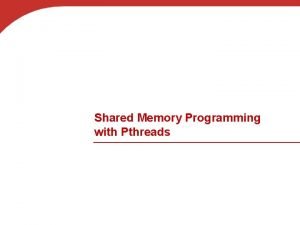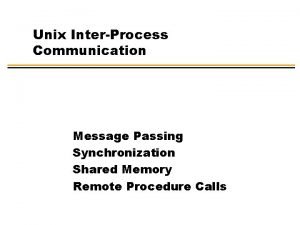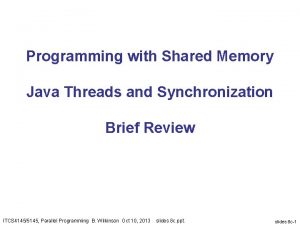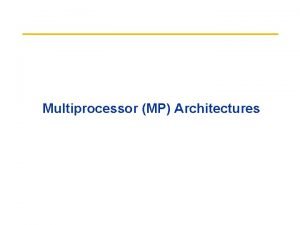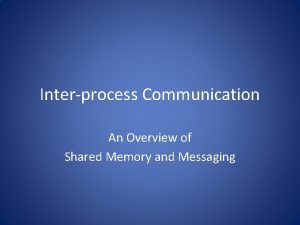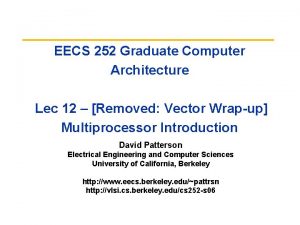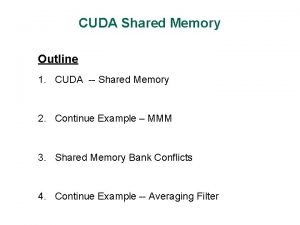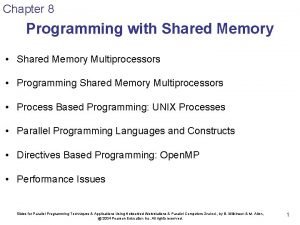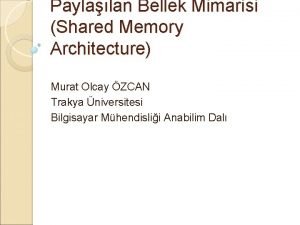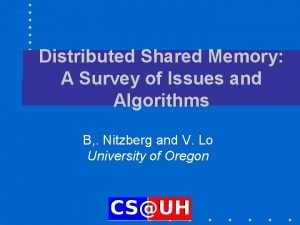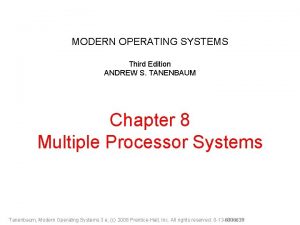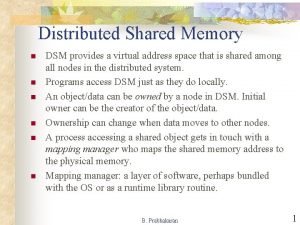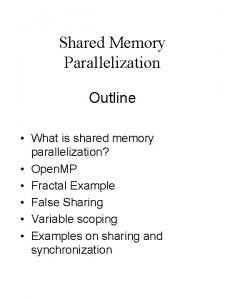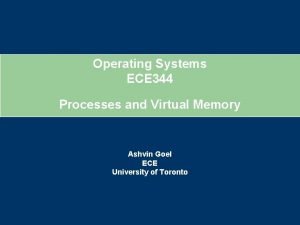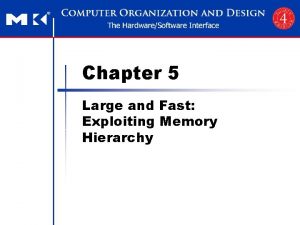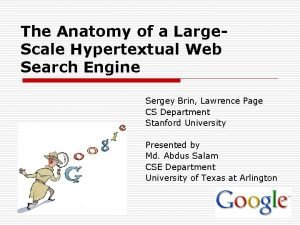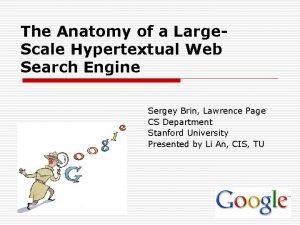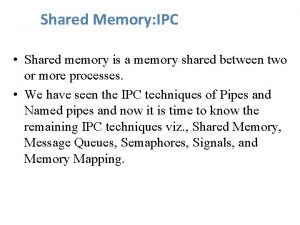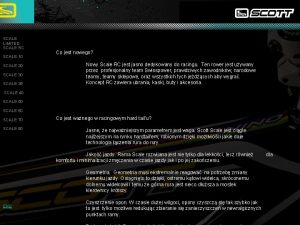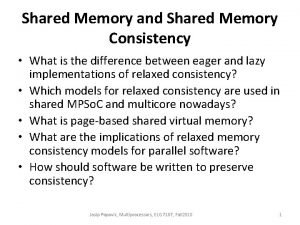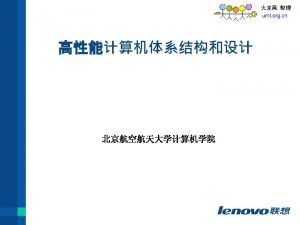Shared Memory Programming for Large Scale Machines C



























- Slides: 27

Shared Memory Programming for Large Scale Machines C. Barton 1, C. Cascaval 2, G. Almasi 2, Y. Zheng 3, M. Farreras 4, J. Nelson Amaral 1 1 University 2 IBM Watson Research Center 3 4 of Alberta Purdue Universitat Politecnica de Catalunya IBM Research Report RC 23853 January 27, 2006 CS 6091 2006 Michigan Technological University 3/15/6 1

Abstract q UPC is scalable and competitive with MPI on hundreds of thousands of processors. q This paper discusses the compiler and runtime system features that achieve this performance on the IBM Blue. Gene/L. q Three benchmarks are used: q HPC Random. Access q HPC STREAMS q NAS Conjugate Gradient (CG). CS 6091 2006 Michigan Technological University 3/15/6 2

1. Blue. Gene/L q 65, 536 x 2 -way 700 MHz processors (low power) q 280 sustained Tflops on HPL Linpack q 64 x 32 3 d packet-switched torus network q XL UPC compiler and UPC runtime system (RTS) CS 6091 2006 Michigan Technological University 3/15/6 3

2. 1 XL Compiler Structure q UPC source is translated to W-code q An early version did as Mu. PC: calls to the RTS were inserted into W-code. This prevents optimizations such as copy propagation and common sub-expression elimination. q The current version delays the insertion of RTS calls. Wcode is extended to represent shared variables and the memory access mode (strict or relaxed). CS 6091 2006 Michigan Technological University 3/15/6 4

XL Compiler (cont’d) q Toronto Portable Optimizer (TPO) can “apply all the classical optimizations” to shared memory accesses. q UPC-specific optimizations are also performed. CS 6091 2006 Michigan Technological University 3/15/6 5

2. 2 UPC Runtime System q The RTS targets q SMPs using Pthreads q Ethernet and LAPI clusters using LAPI q Blue. Gene/L using the Blue. Gene/L message layer q TPO does link-time optimizations between the user program and the RTS. q Shared objects are accessed through handles. CS 6091 2006 Michigan Technological University 3/15/6 6

Shared objects q The RTS identifies five shared object types: q shared scalars q shared structures/unions/enumerations q shared arrays q shared pointers [sic] with shared targets q shared pointers [sic] with private targets q “Fat” pointers increase remote access costs and limit scalability. q (optimizing remote accesses is discussed soon) CS 6091 2006 Michigan Technological University 3/15/6 7

Shared Variable Directory (SVD) q Each thread on a distributed memory machine contains a twolevel SVD containing handles pointing to all shared objects. q The SVD in each thread has THREADS+1 partitions. q Partition i contains handles for shared objects in thread i, except the last partition which contains handles for statically declared shared arrays. q Local sections of shared arrays do not have to be mapped to the same address on each thread. CS 6091 2006 Michigan Technological University 3/15/6 8

SVD benefits q Scalability: Pointers to shared do not have to span all of shared memory. Only the owner knows the addresses of its shared object. Remote access are made via handles. q Each thread mediates access to its shared objects so coherence problems are reduced 1. q Only nonblocking synchronization is needed for upc_global_alloc(), for example. 1 Runtime caching is beyond the scope of this paper. CS 6091 2006 Michigan Technological University 3/15/6 9

2. 3 Messaging Library q This topic is beyond the scope of this talk. q Note, however, that the network layer does not support onesided communication. CS 6091 2006 Michigan Technological University 3/15/6 10

3. Compiler Optimizations q 3. 1 upc_forall(init; limit; incr; affinity) q 3. 2 local memory optimizations q 3. 3 update optimizations CS 6091 2006 Michigan Technological University 3/15/6 11

3. 1 upc_forall q The affinity parameter may be: q pointer-to-shared q integer type q continue q If the (unmodified) induction variable is used the conditional is eliminated. q This is the only optimization technique used. q “. . . even this simple optimization captures most of the loops in the existing UPC benchmarks. ” CS 6091 2006 Michigan Technological University 3/15/6 12

Observations q upc_forall loops cannot be meaningfully nested. q upc_forall loops must be inner loops for this optimization to pay off. CS 6091 2006 Michigan Technological University 3/15/6 13

3. 2 Local Memory Operations q Try to turn dereferences of fat pointers into dereferences of ordinary C pointers. q Optimization is attempted only when affinity can be statically determined. q Move the base address calculation to the loop preheader (initialization block). q Generate code to access intrinsic types directly, otherwise use memcpy. CS 6091 2006 Michigan Technological University 3/15/6 14

3. 3 Update Optimizations q Consider operations of the form r = r op B, where r is a remote shared object and B is local or remote. q Implement this as an active message [Culler, UC Berkeley]. q Send the entire instruction to the thread with affinity to r. CS 6091 2006 Michigan Technological University 3/15/6 15

4. Experimental Results q 4. 1 Hardware q 4. 2 HPC Random. Access benchmark q 4. 3 Embarrassingly Parallel (EP) STREAM triad q 4. 4 NAS CG q 4. 5 Performance evaluation CS 6091 2006 Michigan Technological University 3/15/6 16

4. 1 Hardware q Development done on 64 -processor node cards. q TJ Watson: 20 racks, 40960 processors q LLNL: 64 racks, 131072 processors CS 6091 2006 Michigan Technological University 3/15/6 17

4. 2 HPC Random. Access q 111 lines of code q Read-modify-write randomly selected remote objects. q Use 50% of memory. q [Seems a good match for the update optimization. ] CS 6091 2006 Michigan Technological University 3/15/6 18

4. 3 EP STREAM Triad q 105 lines of code q All computation is done locally within a upc_forall loop. q [Seems like a good match for the loop optimization. ] CS 6091 2006 Michigan Technological University 3/15/6 19

4. 4 NAS CG q GW’s translation of MPI code into UPC. q Uses upc_memcpy in place of MPI sends and receives. q It is not clear whether IBM used GW’s hand-optimized version. q IBM mentions that they manually privatized some pointers, which is what is done in GW’s optimized version. CS 6091 2006 Michigan Technological University 3/15/6 20

4. 5 Performance Evaluation q Table 1: q FE is Mu. PC-style front end containing some optimizations q Others all use TPO front end q no optimizations q “indexing” is shared to local pointer reduction q “update” is active messages q “forall” is upc_forall affinity optimization q Speedups are relative to no TPO optimization q maximum speedup for random and stream is 2. 11 CS 6091 2006 Michigan Technological University 3/15/6 21

Combined Speedup q The combined stream speedup is 241! q This is attributed to the shared to local pointer reductions. q This seems inconsistent with “indexing” speedups of 1. 01 and 1. 32 for random and streams benchmarks, respectively. CS 6091 2006 Michigan Technological University 3/15/6 22

Table 2: Random Access q This is basically a measurement of how many asynchronous messages can be started up. q It is not known whether the network can do combining. q Beats MPI (0. 56 vs. 0. 45) on 2048 processors. CS 6091 2006 Michigan Technological University 3/15/6 23

Table 3: Streams q This is EP. CS 6091 2006 Michigan Technological University 3/15/6 24

CG q Speedup tracks MPI through 512 processors. q Speedup exceeds MPI on 1024 and 2048 processors. q This is a fixed-problem-size benchmark so network latency eventually dominates. q The improvement over MPI is explained: “In the UPC implementation, due to the use of one-sided communication, the overheads are smaller” compared to MPI two-sided overhead. [But the Blue. Gene/L network does not implement one-sided communication. ] CS 6091 2006 Michigan Technological University 3/15/6 25

Comments? I have some … q Recall slide 12: “. . . even this simple [upc_forall affinity] optimization captures most of the loops in the existing UPC benchmarks. ” q From the abstract: “We demonstrate not only that shared memory programming for hundreds of thousands of processors is possible, but also that with the right support from the compiler and run-time system, the performance of the resulting codes is comparable to MPI implementations. ” q The large-scale scalability demonstrated is for two 100 -line codes for the simplest of all benchmarks. q The scalability of CG was knowingly limited by fixed problem size. Only two data points are offered that outperform MPI. CS 6091 2006 Michigan Technological University 3/15/6 26

Week Date Topic 1/18 Organizational meeting 1/25 UPC Tutorial SC 05 Phil Merkey slides 2/1 Mu. PC Runtime System Design PDP 2006 Steve Seidel slides 2/8 Reuse Distance in UPC PACT 05 Steve Carr slides 2/15 UPC Memory Model IPDPS 2004 Øystein Thorsen slides part A slides part B 2/22 Planning meeting 3/1 Communication Optimizations in the Berkeley UPC Compiler PACT 05 Weiming Zhao slides 3/15 UPC on the Blue. Gene/L IBM Research Report RC 23853 Steve Seidel slides 10 3/22 Reuse Distances in UPC Applications Phil Merkey 11 3/29 12 4/6 A UPC Performance Model IPDPS 2006 Steve Seidel 2 3 4 5 6 7 8 9 13 14 4/13 4/20 CS 6091 2006 Michigan Technological University 3/15/6 27
 Shared memory vs distributed memory
Shared memory vs distributed memory Pthread shared memory
Pthread shared memory Small scale or large scale
Small scale or large scale What is statement scale
What is statement scale Large scale map
Large scale map Physical and cultural features of topographic map
Physical and cultural features of topographic map Large scale vs small scale map
Large scale vs small scale map Shared memory in unix
Shared memory in unix Distributed shared memory architecture tutorialspoint
Distributed shared memory architecture tutorialspoint Java shared memory
Java shared memory Share a single centralized memory
Share a single centralized memory Message passing os
Message passing os Symmetric shared memory architecture
Symmetric shared memory architecture Shared memory bank conflicts
Shared memory bank conflicts Symmetric shared memory architecture
Symmetric shared memory architecture Distributed shared memory
Distributed shared memory Shared memory approaches in distributed system
Shared memory approaches in distributed system Shared memory nedir
Shared memory nedir Design issues of distributed shared memory
Design issues of distributed shared memory Acc shared memory
Acc shared memory Shared virtual memory
Shared virtual memory Advantages and disadvantages of mimd
Advantages and disadvantages of mimd Distributed shared memory
Distributed shared memory What is shared memory
What is shared memory Memory mapped file
Memory mapped file Large and fast: exploiting memory hierarchy
Large and fast: exploiting memory hierarchy The anatomy of a large scale hypertextual web search engine
The anatomy of a large scale hypertextual web search engine The anatomy of a large scale hypertextual web search engine
The anatomy of a large scale hypertextual web search engine

